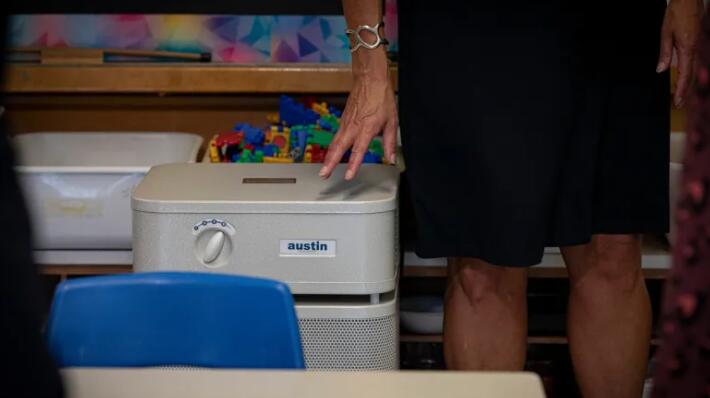Vancouver mother lodges regulatory complaint against school district over ventilation

Complaint sparks discussion over whether organizations can be held liable for virus spread in buildings
A Vancouver mother has filed a regulatory complaint against the Vancouver School Board (VSB), asking for a professional engineer’s assurance that her children are protected against COVID-19.
Tracy Casavant, who has two children attending elementary school, filed the complaint with Engineers and Geoscientists B.C. (EGBC) last week.
Casavant says she reached out to the school board asking for an authenticated document by a registered engineer — something required as part of regulatory codes — underpinning the school board’s decisions around ventilation and COVID-19 mitigation.
When she didn’t receive the document she asked for, she went to the regulator.

“I would like the assurance from the proper professional that my building is safe,” Casavant, who holds an engineering degree and practiced for many years, told CBC News. “And, I would like to know from a technical standpoint what ‘safe’ means.
“Those are important questions, especially as an immunocompromised parent.”
The complaint comes amid spiking concern among B.C. parents that a lack of appropriate ventilation in schools will lead to COVID spread among vulnerable children.
Casavant said her interpretation of the EGBC ethics code, which states that engineers “hold paramount the safety, health, and welfare of the public,” means regulated engineers should assume some responsibility for the spread of pathogens like COVID-19.
A VSB spokesperson said they were “aware of a complaint,” and that they would be following the necessary procedures required by the regulator.
“We are confident that the complaint is wholly without merit as the school district relies on guidance from the ministries of health and education,” the spokesperson said.
“VSB’s facilities and ventilation equipment are currently set to bring in generous amounts of outdoor air as part of COVID preventative actions.”
- Some parents, teachers want stricter guidelines around COVID in schools this fall
- Parents left frustrated as schools, districts reject donations of air filters for classrooms
The spokesperson said 2,000 Vancouver classrooms have mechanical ventilation, and three portables in the district have HEPA filtration in the absence of mechanical ventilation. Plans are underway to install mechanical ventilation in those portables too, according to the spokesperson.
When asked if the school board has the document requested by Casavant, however, the spokesperson did not answer.
A spokesperson for the Health Ministry said it was committing $166.5 million to help school districts upgrade ventilation.
Can organizations be held liable for COVID-19 spread?
Casavant’s complaint has sparked discussion about cleaner air in schools, and whether school districts should be held liable for pathogen spread in their buildings.
“The notion of liability is going to be a big question,” said Dr. Damien Contandriopoulos, a professor at the University of Victoria School of Nursing. “I think this is going to be a central component of the debates about COVID in the near future.”
Contandriopoulos said he wouldn’t be able to answer whether organizations could be held legally responsible for virus spread. But when it came to whether they were ethically responsible, he said he believed so.
- Calls grow for HEPA air filters in Canadian classrooms
- HEPA filters can only help combat COVID-19 in classrooms, says expert
He said the lack of institutional and governmental mandates around cleaner air showed a lack of responsibility, saying the filtration of air was as important in disease mitigation as filtering drinking water.
“You cannot expect every institution … to do the right thing unless you have some form of regulation,” he said.

Contandriopoulos pointed to the University of Toronto’s ventilation upgrades this summer as an example of what a proactive approach to clean air looks like in an educational setting.
Classrooms in Quebec are also equipped with carbon dioxide monitors to monitor the quality of the air students breathe, helping limit the spread of COVID-19 — though advocates in that province have also been critical of ventilation levels in schools.
“We know also that making sure that the air does not include [high carbon dioxide levels] will increase the capacity of little kids,” he said. “It’s impossible to identify any downside of making sure the air people breathe is clean.”
Push for cleaner air in building codes
The VSB’s communicable disease plan says it follows an international standards body, the American Society of Heating, Refrigerating and Air-Conditioning Engineers (ASHRAE), in developing its ventilation guidelines.
ASHRAE creates standards and guidelines that underpin many building codes — including the B.C Building Code.
But the ASHRAE guidance being relied on by the VSB is outdated and was written before the scientific consensus showed COVID-19 is airborne, according to Dr. William Bahnfleth from Pennsylvania State University.
- Some parents frustrated as B.C. removes ‘layer of protection’ in schools by dropping mask mandate
- Human rights complaint filed against B.C. health-care authority over N95 respirator ban
Bahnfleth chairs ASHRAE’s epidemic task force, which publishes recommendations regularly around building standards and COVID-19.
“In the building codes for non-healthcare buildings, there generally isn’t ventilation requirements for the purpose of infection control,” he said. “Which is, you know, part of the problem.”
The B.C. Building Code makes a broad reference to “indoor air contaminants,” saying they “should not be permitted to accumulate in concentrations greater than those permitted by applicable provincial guidelines”.
Related News
Canada’s digital services tax set for a reckoning with U.S.
The fight over Canada’s controversial digital services tax may escalate this week as the deadlineRead more
Trump makes triumphant return to Washington, meets with Biden
Donald Trump made a victor’s return to Washington on Wednesday, visiting the White House forRead more
